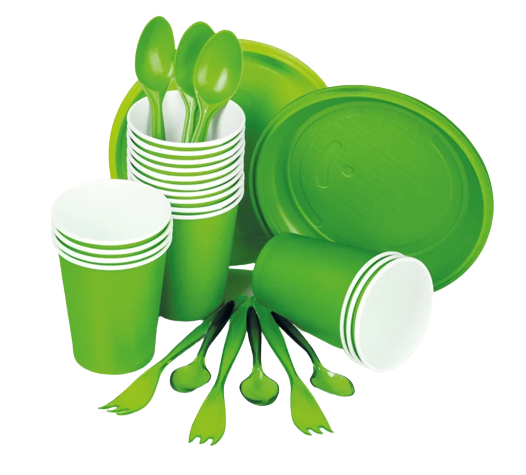BioPlastic. RENEWABLE
RENEWABLE BIO-DEGRADABLE (*SOME, NOT ALL)
BIO-DEGRADABLE (*SOME, NOT ALL) RECYCLABLE
RECYCLABLE

Types of BioPlastic options available
Shop all of BioPlastic products.
All Categories
BioPlastic bags

Go shopping
Description :
 Carbon Footprint: 1 to 4 kilograms per kg
Carbon Footprint: 1 to 4 kilograms per kg
 Time to decompose : a few months to a few years
Time to decompose : a few months to a few years
 Recyclability : single use
Recyclability : single use
 Price Range : $ 0.50 to 2.00*
Price Range : $ 0.50 to 2.00*
Read More
Plates and cutlery

Go shopping
Description : Sustainable alternative to plastic utensils. Made from renewable resources, bioplastic cutlery is compostable, reduces environmental impact, and offers an eco-friendly option for single-use utensils.
 Carbon Footprint: 500 to 900 kg CO2e per tonne
Carbon Footprint: 500 to 900 kg CO2e per tonne
 Time to decompose : 2 to 6 weeks in facility
Time to decompose : 2 to 6 weeks in facility
 Recyclability : 4 to 6 times
Recyclability : 4 to 6 times
 Price Range : $ 0.15 to 0.30*
Price Range : $ 0.15 to 0.30*
Read More
Zipper Bags

Go shopping
Description : Bioplastic zipper bags are eco-friendly alternatives to traditional plastic bags. They are made from renewable resources and can break down more easily in composting or anaerobic digestion.
 Carbon Footprint: 1.4 to 3.4 kg CO2 per Kg
Carbon Footprint: 1.4 to 3.4 kg CO2 per Kg
 Time to decompose : 7 to 8 months
Time to decompose : 7 to 8 months
 Recyclability : 2 to 3 times
Recyclability : 2 to 3 times
 Price Range : $ 0.10 to 0.25*
Price Range : $ 0.10 to 0.25*
Read More
PVC Cling Flims

Go shopping
Description : Bioplastic cling films are sustainable alternatives to traditional plastic wraps. They are made from renewable sources and are biodegradable or compostable, reducing environmental impact.
 Carbon Footprint:
Carbon Footprint:
 Time to decompose : 7 to 8 months
Time to decompose : 7 to 8 months
 Recyclability : 6 to 7 times
Recyclability : 6 to 7 times
 Price Range : $ 2.00 to 3.00*
Price Range : $ 2.00 to 3.00*
Read More
Sugarcane Cling Flims

Go shopping
Description : Bioplastic cling films are sustainable alternatives to traditional plastic wraps. They are made from renewable sources and are biodegradable or compostable, reducing environmental impact.
 Carbon Footprint: 1.3 kg CO2 per kg
Carbon Footprint: 1.3 kg CO2 per kg
 Time to decompose : 3 months
Time to decompose : 3 months
 Recyclability : 2 to 3 times
Recyclability : 2 to 3 times
 Price Range : $ 7.00 to 8.00*
Price Range : $ 7.00 to 8.00*
Read More
Tapioca Starch Bags

Go shopping
Description : Tapioca starch packaging bags are eco-friendly alternatives to traditional plastic bags. They are made from tapioca starch, a renewable and biodegradable material, reducing environmental impact.
 Carbon Footprint: 1.3 kg CO2 per kg
Carbon Footprint: 1.3 kg CO2 per kg
 Time to decompose : 3 months
Time to decompose : 3 months
 Recyclability : 2 to 3 times
Recyclability : 2 to 3 times
 Price Range : $ 7.00 to 8.00*
Price Range : $ 7.00 to 8.00*
Read More
Sugarcane Bagasse Box

Go shopping
Description : Sugarcane bagasse boxes are eco-friendly alternatives to traditional packaging. They are made from the fibrous residue of sugarcane, reducing waste and offering a sustainable solution.
 Carbon Footprint: 1.3 kg CO2 per kg
Carbon Footprint: 1.3 kg CO2 per kg
 Time to decompose : 3 months
Time to decompose : 3 months
 Recyclability : 2 to 3 times
Recyclability : 2 to 3 times
 Price Range : $ 0.06*
Price Range : $ 0.06*
Read More
PVDC & PLA Stretch Film

Go shopping
Description : PVDC & PLA stretch film combines the properties of PVDC (polyvinylidene chloride) and PLA (polylactic acid) to create a versatile packaging material with enhanced barrier properties and biodegradability.
 Carbon Footprint: 1.5 to 3.5 kg CO2 per Kg
Carbon Footprint: 1.5 to 3.5 kg CO2 per Kg
 Time to decompose : 7 to 8 months
Time to decompose : 7 to 8 months
 Recyclability : 1 to 2 times
Recyclability : 1 to 2 times
 Price Range : $ 3.00*
Price Range : $ 3.00*
Read More
About BioPlastic packaging
- Renewable Feedstocks: Bioplastic packaging is typically derived from renewable resources such as plant-based feedstocks. These feedstocks include sugarcane, cornstarch, cellulose, and vegetable oils. Using renewable feedstocks reduces reliance on fossil fuels and promotes a more sustainable production process.
- Reduced Carbon Footprint: Bioplastics have the potential to contribute to a lower carbon footprint compared to traditional petroleum-based plastics. The production of bioplastics often generates fewer greenhouse gas emissions, primarily due to the absorption of carbon dioxide during the growth of the renewable feedstocks used as raw materials.
- Versatile Applications: Bioplastics can be used in a wide range of packaging applications. They are suitable for various products, including food and beverage packaging, personal care products, and consumer goods. Bioplastics can be manufactured to possess similar properties to conventional plastics, such as durability, flexibility, and transparency.
- Biodegradable and Compostable Options: Some types of bioplastics are biodegradable and compostable. These materials can break down naturally under specific conditions, such as in industrial composting facilities or in soil, into organic compounds. Biodegradable and compostable bioplastics offer an additional end-of-life option, particularly for single-use packaging, reducing waste and environmental impact.
- Recycling Challenges: While bioplastics offer sustainability benefits, their recyclability can be challenging. Bioplastics are often not compatible with traditional recycling processes for petroleum-based plastics, and mixing them can contaminate the recycling stream. Specialized recycling facilities and processes are required to effectively recycle bioplastics, which are not widely available in all regions.


